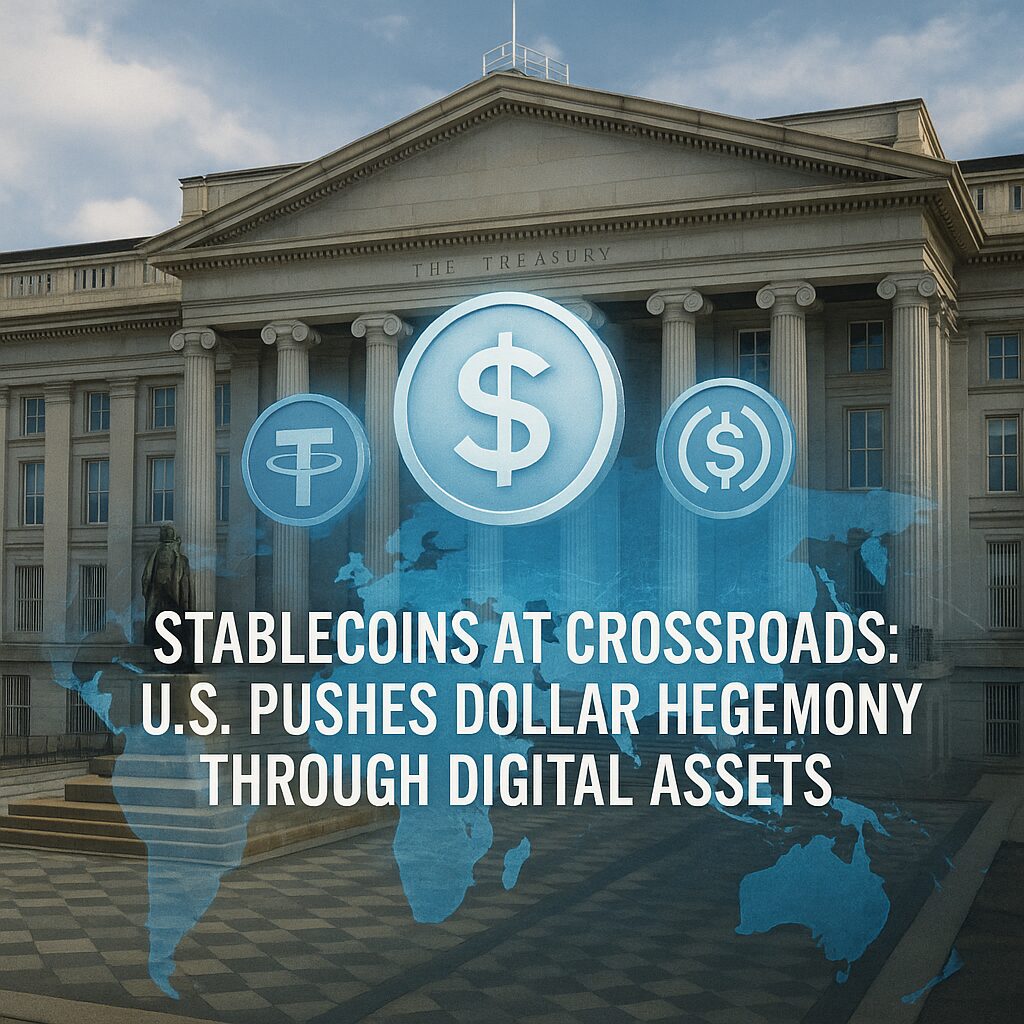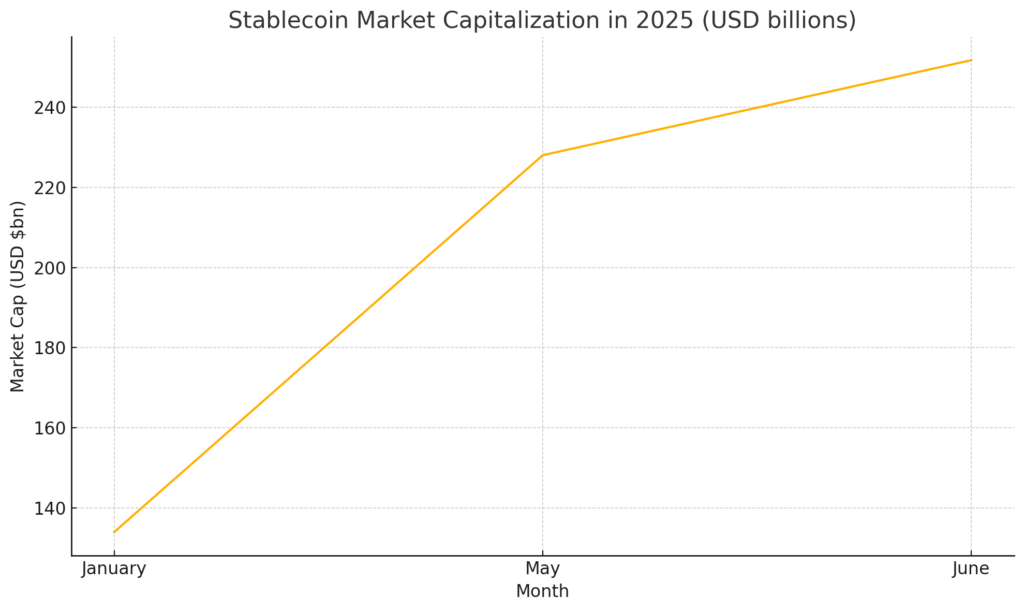
Main Points:
- U.S. administration fast-tracks the bipartisan GENIUS Act to regulate dollar-pegged stablecoins as a means to bolster dollar hegemony.
- Record stablecoin market capitalization hits $251.7 billion, up 22% year-to-date, driven by trading demand and institutional interest.
- Italy warns stablecoins threaten euro sovereignty; BIS and Amundi caution about financial stability and “dollarization” risks.
- BRICS nations explore multi-currency payment frameworks and local stablecoins to reduce reliance on the dollar.
- UAE moves ahead with a dirham-pegged stablecoin by ADQ, IHC, and FAB, signaling regional embrace of digital assets.
- Emerging markets’ retail demand surges amid inflation and local currency volatility.
- Institutional forecasts predict stablecoin market could reach $500 billion–$2 trillion by 2030, with substantial Treasury purchases by issuers.
1. U.S. Policy Drive: The GENIUS Act and Dollar Hegemony
The Guiding and Establishing National Innovation for U.S. Stablecoins Act (GENIUS Act) represents the first comprehensive federal framework for payment stablecoins in U.S. history. Introduced by Senator Bill Hagerty (R-TN) on May 21, 2025, and passed by the Senate on June 17, 2025, with a decisive 68-30 vote, the bill mandates strict reserve, audit, and transparency requirements for issuers and establishes dual federal-state oversight to mitigate consumer and financial stability risks.
The Biden administration, backed strongly by Treasury Secretary Scott Bessent and President Trump’s “Special Assistant for Crypto and AI” David Sachs—chair of the President’s Science and Technology Advisory Council—has lobbied Congress to expedite the Act’s passage through the House during “Crypto Week” (July 14–20). This policy thrust underscores Washington’s view of dollar-pegged stablecoins as critical instruments for arresting any erosion in the U.S. dollar’s status as the world’s primary reserve currency.
While proponents argue that regulated stablecoins could foster payment innovation and deepen financial markets, critics warn that unchecked expansion may increase the U.S. Treasury’s funding needs—potentially weakening, rather than strengthening, the dollar. Amundi’s CIO Vincent Mortier cautioned that mandatory Treasury bond purchases to back stablecoins might inadvertently add pressure on U.S. deficits and could “more weaken the dollar” if foreign populations adopt these tokens en masse.
2. Record Market Surge: Figures and Trends
Stablecoin market capitalization has reached unprecedented levels in 2025. According to CoinDesk data, the industry hit $251.7 billion on June 18, up 22% year-to-date. Earlier in the year, the sector crossed $200 billion in January—marking the highest four-month consecutive growth since early 2023 —and surged to $228 billion by May, reflecting renewed trading activity and payment use cases.
<details> <summary><strong>Figure: Stablecoin Market Cap Growth (USD billions)</strong>

</summary> The table and chart above illustrate the market cap trajectory from January ($134 bn) to June ($251.7 bn), highlighting rapid expansion amid regulatory clarity and heightened institutional participation. </details>
Major stablecoins Tether (USDT) and Circle’s USDC continue to dominate, collectively accounting for over $216 billion or approximately 86% of total supply. Institutional adoption has been bolstered by Treasury backing; Circle reported that 99% of its USDC reserves are held in U.S. Treasuries, raising questions about revenue risks in a prospective rate-cut environment.
3. Global Reactions: Sovereignty Concerns and Alternative Initiatives
3.1 European Warning: The Euro Under Threat
Italy’s Economy Minister Giancarlo Giorgetti has declared U.S. stablecoin policy a greater peril to European monetary sovereignty than Trump’s tariffs, urging EU institutions to accelerate the digital euro project to counterbalance dollar-pegged tokens. He warned that stablecoins enable cross-border payments and “risk-free” savings without requiring U.S. bank accounts, potentially luring eurozone citizens.
The Bank for International Settlements (BIS) echoed these concerns in its June report, stating that stablecoins “fall short as sound money” and, without robust regulation, “pose a risk to financial stability and monetary sovereignty,” given that dollar-pegged coins represent 99% of the $260 billion market.
3.2 BRICS: Multi-Currency Cross-Border Payment Plans
The BRICS bloc—Brazil, Russia, India, China, and South Africa—is exploring a multi-currency payment framework (“BRICS Pay” and the proposed BRICS Bridge) to enable cross-border settlements in national currencies, reducing dependence on the U.S. dollar. At the 2025 summit in Rio de Janeiro, leaders reaffirmed plans for a payment messaging system to facilitate smoother transactions and strengthen economic collaboration within the bloc.
China’s tech giants are also actively pursuing stablecoin initiatives. Ant International is “seriously considering” stablecoin license applications in offshore jurisdictions, focusing on enhancing global payment efficiency rather than facilitating crypto trading. Concurrently, Hong Kong will implement stablecoin licensing regulations from August 1, positioning itself as a testing ground for potential renminbi-pegged tokens.
3.3 Middle East: UAE Dirham Stablecoin Takes Shape
In Abu Dhabi, sovereign wealth fund ADQ, IHC, and First Abu Dhabi Bank (FAB) announced plans in April 2025 to launch a dirham-pegged stablecoin, pending regulatory approval from the UAE central bank. The token, to be issued by FAB on the ADI blockchain, aims to serve everyday consumer, enterprise, and emerging machine-to-machine use cases, reinforcing the UAE’s ambition to become a digital assets hub.
Dubai’s Virtual Assets Regulatory Authority (VARA) has already approved USDC and EURC within the DIFC free zone, and regional airlines like Air Arabia accept the AE Coin for flight bookings—further evidence of the Gulf’s embrace of stablecoins as part of its fintech transformation.
4. Emerging-Market Demand: Seeking a Stable Store of Value
High inflation and currency depreciation in emerging economies have fueled retail demand for dollar-pegged stablecoins as a store of value. The Signum report highlights that U.S. policymakers view stablecoins as a tool to meet this demand and thus preserve the dollar’s global role. However, Signum’s Research Head Katalin Tischauser cautioned that stablecoins’ impact on dollar dominance will remain limited unless small-ticket usage in developing markets significantly accelerates .
Peer-to-peer stablecoin transactions have grown markedly in countries like Nigeria and Turkey, where citizens leverage tokens to hedge against local currency volatility and access global commerce. According to data from CCData, B2B payment transactions using stablecoins totaled $36 billion run rate in early 2025, illustrating corporate adoption alongside retail use.
5. Institutional Forecasts and Future Outlook
Analysts project that stablecoin market capitalization could double to $500 billion or even reach $2 trillion by 2030, driven by deepening integration into payments, treasury operations, and DeFi protocols. JPMorgan forecasts a doubling to $500 billion in the next few years, while Bloomberg’s analysis suggests a potential $3.7 trillion market by decade’s end, contingent on regulatory clarity and technological adoption.
Stablecoin issuers have become significant buyers of U.S. Treasuries, supporting liquidity but also raising concerns about concentration risk. Paxos and other issuers purchased over $50 billion of Treasuries in Q1 2025 alone, as they seek safe-asset yields to back $252 billion in stablecoin supply.
Yet challenges remain: reserve transparency, operational resilience, and interoperability with legacy systems. Standard-setting bodies and central banks continue to debate frameworks for stablecoin issuance, with the IMF emphasizing the need for global coordination to prevent regulatory arbitrage and preserve financial stability.
Conclusion
Stablecoins stand at a critical juncture in mid-2025. U.S. policymakers have embraced them as instruments to sustain dollar supremacy, enshrining regulations through the GENIUS Act. Meanwhile, global reactions span from Europe’s digital euro race to BRICS’s multi-currency ambitions and the UAE’s dirham-pegged initiative. Retail demand surges in emerging markets, while institutional forecasts predict exponential growth. Nonetheless, stablecoins’ future hinges on striking the right balance between innovation, oversight, and sovereignty concerns. As regulators move from threat to framework, stablecoins may reshape the landscape of global finance—either entrenching existing power structures or enabling a more multipolar monetary order.

